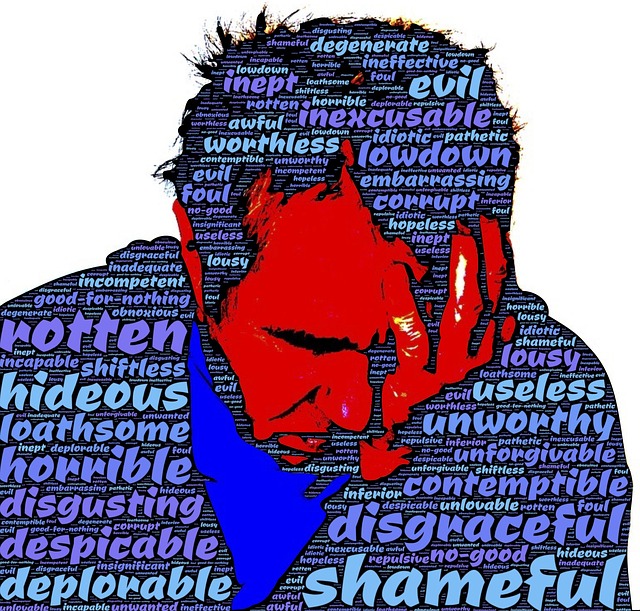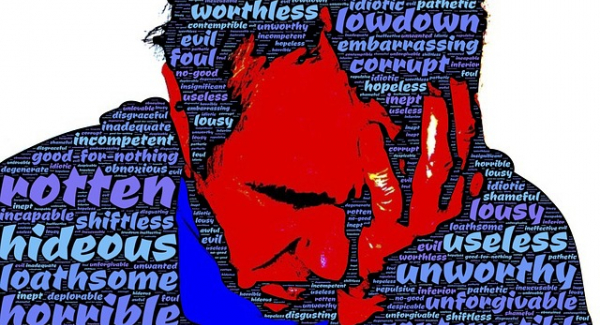Imagine that your national football team has to play against the team of a neighboring country. You are very excited about this event and invited your friends over to watch the game together. When the other team scores a second goal and is winning, you see that the football fans of that team are burning your national flag in the stadium. How would you feel, if that were to happen? What would you think about the football fans of the other team? How would you react?
In such a situation, you may become very angry and ashamed, and it is most likely that you will feel humiliated. Your country is dishonored because your national symbol has been destructed. This is humiliating and you believe that your national team and country did not deserve such treatment. As a consequence, you may also feel the urge to aggress, either verbally or physically.
This example illustrates how feelings of humiliation may be elicited when there is an outside threat to the reputation of important in-groups. In addition to nations, other important groups may be family, churches, army units, departments at the work place, etc. Hence, you could feel intense emotions if you and your parents are the only ones left uninvited to the wedding of your first cousin, or when a member of a religious group with which you strongly identify (e.g., Catholic) has been publicly revealed to have committed an offence (e.g., having sex with minors). The humiliation felt in such situations is a powerful emotion, not only because of the pain it causes with regard to one’s self-esteem, but also because of the implications for in-group relationships. Feelings of humiliation may also influence the relation with other groups (e.g. the relationship between non-Catholics and Catholics after the wrongdoing of a member of the latter group has become public).
Humiliation is thus not only an emotion felt at the individual level, but also in situations in which one’s group is humiliated, and this is the focus of the current paper. The experience of humiliation is highly negative and is elicited when one’s self-esteem is challenged. In some cultures and contexts, this self-esteem extends to one’s reputation, one’s self-esteem in the eyes of others. Individual honor is generally defined as the value attributed to the self, based on both how people see themselves and what others think of them (Pitt-Rivers, 1965, 1968, 1977, as cited by Mosquera et al., 2002). Honor also occurs at a group-based level, however, when it is shared by a group of people who are related to each other (Mosquera et al., 2002). In attempting to restore one’s honor and to prevent humiliation, people may engage in psychologically and physically violent behaviors that damage social relationships. Thus, humiliation should not only be regarded as negative for oneself, but especially negative for intergroup relations.
Yet, very little is known about the causes and nature of humiliation in intergroup contexts, and its relation with group-based honor. Is humiliation caused by in-group derogation, a threat that leads to intergroup conflict? The current paper will provide a review of the literature on group-based humiliation, with the aim to examine whether humiliation is more likely to be elicited in honor-based cultures than in other cultures.
What is group-based humiliation?
In everyday language, we use the word humiliation in two different ways. First, we use it to refer to an act or situation that degrades another person or group, for example insulting or publicly threatening the reputation of a person or a group. Second, the word humiliation is used to refer to the emotion associated with being downgraded by someone. It is then defined as “a deep dysphoric feeling, associated with being, or perceiving oneself as being unjustly degraded, ridiculed and put down – in particular, one’s identity has been demeaned or devalued” (Hartling & Luchetta, 1999, p. 264). In case of group-based humiliation, it is the in-group identity that is demeaned and devalued. Similar to other group-based emotions, group-based humiliation is influenced by intergroup relations and may be the result of an appraisal of group-based threats or attacks from out-groups (Mackie et al., 2000).
Early theorizing about humiliation originates from research on peer bullying. In peer-violence situations interpersonal derogation serves to establish control or to maintain dominance over ‘weak peers’ by causing humiliation. Likewise, humiliation can be seen as a means of control and social oppression on a much larger scale as well (Giacaman et al., 2007; Lindner, 2001). According to Giacaman et al. (2007) and Lindner (2001), humiliation in intergroup conflicts can be a control tactic that is usually employed by dominant groups towards the weaker ones. However, also weaker groups can humiliate more dominant ones (Otten, Jonas, Doosje, & Erbas, 2011) and, as Smith (2008) argues, people who experience humiliation may temporarily react with acceptance and submission, but they may later develop anger or resentment toward others.
In their research on humiliation in the lives of Palestinians, Somalis and people from other conflict zones, Lindner (2001) and Giacaman and colleagues (2007) found that experiencing repeated humiliating acts generates trauma and high psychological distress. Victims of humiliation generally believe that the treatment they are receiving from others is intentional and undeserved (Ellison & Harter, 2007). Humiliating acts are aimed at the core identity of the person (Hartling & Luchetta, 1999), and do not only threaten self-esteem, but also the ability to belong to a group (Statman, 2000). Humiliation may be experienced in different ways: as a state of defeat or conquest in moments when people are made to believe that they are subordinated and dependent on others (Smith, 2008), as degradation when people feel being pushed down in the social hierarchy of a group, and as rejection and exclusion, when humiliating acts make people feel unworthy and not part of the social group (Statman, 2000; Smith 2008).

How strongly is humiliation associated with other negative emotions? Humiliation seems to include aspects of shame, embarrassment and anger (Miller, 1993; Ellison & Harter, 2007). According to Miller (1993), these emotions are similar, because they are evoked when one’s reputation and social status are threatened, and develop when there is an audience that witnesses the event. They all point to a negative perspective on one’s self, a feeling of deep pain, resulting in a desire to withdraw or shy away. However, humiliation differs from shame and embarrassment in two manners.
First, humiliation involves a stronger sense of unfairness and devaluation of self-importance by others than do shame and embarrassment (Miller, 1993). In this vein, Hartling and Luchetta (1999) argue that while humiliation is experienced when one has been unjustly downgraded, shame involves an internal negative evaluation of oneself that can occur without the embarrassment or humiliation of public judgment. Moreover, embarrassment occurs when outsiders become aware of a shame-inducing event, but humiliation is a broader, deeper sense of degradation one experiences when public ridicule takes place.
Secondly, humiliation is not only associated by a state of pain, and a desire to escape degradation, but also by a strong desire to retaliate, which is not typical of shame and embarrassment (Miller, 1993; Giacaman et.al., 2007; Lindner, E. G., 2001; Smith et al, 2002, Smith, 2008).
For instance, people could feel shame if a family member has been jailed for stealing, and embarrassment if some of the neighbors show curiosity about the reasons that pushed the relative to steal. However, people would experience humiliation if they hear the neighbors gossiping about the whole family and pointing at them when they are walking in the neighborhood.
On the other hand, concepts like other-blaming, perception of injustice and antagonistic tendencies make humiliation similar to anger. Whereas people feel anger when they believe that others have wronged them by obstructing their personal or in-group goals, people feel humiliation when the unjust behavior consists of attempts to degrade one’s personal or in-group identity. This is why humiliation includes not only anger, but also pain and shame.
Humiliation experienced after in-group derogation may lead to different types of behavioural or expressive reactions, such as conforming to the norms of dominant persons or groups, attempting to escape further humiliation, developing resistance or seeking revenge (Smith, 2008). The question is why people react differently in response to a degrading treatment? We believe that the behavioral and expressive implications of humiliation are strongly affected by the loss of honor. Since the conceptualization of honor varies with cultures and social groups, it is necessary to examine the role of honor in different cultures, in order to better understand its role in the nature of humiliation.
Why is honor so relevant?
Honor is considered an important individual value in almost every culture. Being an honorable person, coming from an honorable family, or having an honorable profession is often regarded highly. This mentality is even more strongly emphasized in societies in which individuals maintain strong interdependent relationships with each other, and the personal reputation is crucial in the social organization of the society. Honor thus not only helps the preservation of one’s self-esteem, it is also important for the balance of intergroup relationships within a community. This makes honor a value shared among individuals in a group, thus a group attribute.
Honor-oriented groups offer a specific type of membership value to their members. Group membership generally forms a big part of people’s self-concept and has a special emotional value (Tajfel & Turner, 1986). Identification with a specific group and the importance that is attributed to group membership depends on several factors. One of the most important in-group identification determinants is the centrality of group membership to the self-concept (Leach et al., 2008). In honor-oriented groups, honor seems to serve the function of centrality. It makes the group events central to the personal experience. As a consequence, when losing honor, the individual and group reactions are usually intense.
In some cultures, losing honor means losing those properties that define an individual’s social status and reputation in society (Cohen et al., 1998). In order to protect one’s honor, individuals attempt to maintain stable and fair relationships within the community. By seeking harmony and mutual respect within the community, potentially humiliating events are prevented.

However, when honor is being threatened or even violated, aggressive reactions may be incited. In some cases, these aggressive acts may lead to hurting and eliminating those that humiliate the self or the in-group. These crimes, widely known as honor crimes, “vendettas”, or “blood feuds”, aim at reinstating the lost honor of the family or other highly important in-groups (Cohen et al., 1998). These behaviors are more prevalent in cultures considered as “cultures of honor” (Cohen et al., 1996; Cohen et al., 1998). As a consequence, the gravity of emotional reactions that follow the loss of honor vary across different cultures.
Honor, Culture and Humiliation
To fully comprehend the development and expression of emotions, it is important to understand the cultural features of the social contexts in which they are instigated. Based on the level of cooperation, competition, and individuality, cultures are categorized in two groups: collectivistic and individualistic (Markus & Kitayama, 1991; Triandis et al., 1998). While collectivistic cultures are defined by “the self-definition based on the group, subordination of personal goals to in-group goals, concern for the integrity of the group and emotional attachment to the group” (Triandis et al., 1998, p. 335), individualistic cultures are characterized by self-definition based on personal goals and weaker emotional bonds with the groups. According to Triandis et al., (1998), the in-group is demarcated differently in different cultures. In collectivistic cultures people tend to consider the family and kinship related by blood their primary in-group, while in individualistic cultures people define their in-groups more broadly as "people who are like me in the social class, race, beliefs, attitudes, and values" (Triandis et al., 1998, p. 326).
Among collectivistic cultures, Mediterraneans have developed a much more important sense of family as a primary group (Mosquera et al., 2002). The family in these societies is a group that shares a common identity expressed in the concept of family honor (Mosquera et al., 2002). According to Miller (1993), honor in these societies is strongly related to the social image and is concerned with avoiding humiliation. However, a similar concept of honor may also exist among East Asian cultures (Markus & Kitayama, 1991) and the Southern States of the United States (Cohen et al., 1998) where people maintain interdependent selves, and are highly concerned with saving their social images.

These characteristics of cultures affect the development and expression of emotions (Fischer et al, 1999). Indeed, Mosquera and colleagues (2008) have shown that while the reported intensity of shame did not differ among non-honor-oriented group (Dutch people) and honor-oriented group (Spanish people), their motivational reactions were different: While the Dutch participants tended to withdraw from the personal insult situation, Spanish participants had the tendency to express verbal disagreement.
It is interesting that the difference between cultures is expressed not only in terms of behavioral tendencies but also in how strongly one feels humiliation and anger. In a cross-cultural study conducted by Doosje et al. (2011), aimed at comparing the experience of national humiliation in honor-oriented cultures (Albania and Hong Kong) versus non-honor-oriented cultures (The Netherlands), they found that a dishonoring event concerning the nation leads to stronger humiliation and anger in honor-oriented cultures than in non-honor-oriented cultures. Most importantly, the importance of honor explained this difference. In addition, the participants from honor-oriented cultures reported more aggression than the non-honor-oriented cultures. Specifically, the tendency to humiliate the attacker was reported more often by the Albanian than the Dutch participants, while the Dutch and Hong Kong participants did not differ from each other. Furthermore, the Hong Kong participants reported a stronger withdrawal tendency than the Dutch participants, while the Dutch and Albanian participants did not differ from each other. Evidently, in-group derogation evokes different emotional reactions among people of different cultures. Thus, importance of honor in the social organization of a society has a large impact on the development of emotions such as humiliation, shame and anger.
To conclude, we argue that understanding group-based humiliation and its relation with group honor is important. As we have indicated, the experience of humiliation is highly negative and may lead to a difficult coping process since the value of the self or in-group may be threatened and the relationships with others may deteriorate. By exploring the sources of humiliation, its experience and its implications in different types of social groups and intergroup contexts, research can provide comprehensive knowledge on the conceptualization of this emotion. Moreover, as we have indicated, group-based humiliation is differently experienced in cultures that vary in the centrality of honor values. Therefore, mechanisms developed for understanding and preventing consequences of humiliation should take into consideration the cultural characteristics of the groups.
References
Cohen, D., Nisbet, R. E., Bowdle, B. F., & Schwarz, N. (1996). Insult, aggression and the southern culture of honor: An experimental ethnography. Journal of Personality and Social Psychology, 70, 945-960.
Cohen, D., Vandello, J., & Rantilla, A. K. (1998). The sacred and the social cultures of honor and violence. In P. Gilbert & B Andrews (Eds.), Shame. Interpersonal Behavior, Psychopathology, and Culture (pp. 225-245). New York: Oxford University Press.
Doosje, B., Jasini, A., Jonas, K., & Sveinsdóttir, G. (2011). When your nation has been dishonored: Group-based humiliation in different cultures. Manuscript in preparation.
Doosje, B., Ellemers, N., & Spears, R. (1995). Perceived intragroup variability as a function of group status and identification. Journal of Experimental Social Psychology, 31, 410-436.
Ellison, J., & Harter, S. (2007). Humiliation, causes, correlates, and consequences. In J. L. Tracy, R. W. Robins, & J. P. Tangney (Eds.), The self-conscious emotions: Theory and research (pp. 3-20). New York: Guilford.
Fischer, A. H., Manstead, A. S. R., & Mosquera, P. M. R. (1999). The role of honor-related vs. individualistic values in conceptualizing pride, shame and anger: Spanish and Dutch cultural prototypes. Cognition and Emotion, 13, 149-179.
Giacaman, R., Abu-Rmeileh, N. M. E., Husseini, A., Saab, H., & Boyce, W. (2007). Humiliation, the invisible trauma of war for Palestinian youth. Public Health, 121, 563-571.
Gilbert, P. (1998). What is shame? Some core issues and controversies. In P. Gilbert & B Andrews (Eds.), Shame. Interpersonal behavior, psychopathology, and culture (pp. 225-245). New York: Oxford University Press.
Hartling, L. M., & Luchetta T. (1999). Assessing the impact of derision, degradation and debasement. The Journal of Primary Prevention, 19, 259-278.
Hornsey, M. J., Oppes, T., & Svensson, A. (2002). “It’s OK if we say it, but you can’t”: responses to intergroup and intragroup criticism. European Journal of Social Psychology, 32, 293-307.
Leach, C. W., van Zomeren, M., Zebel, S., Vliek, M., Pennekamp, S. F., Doosje, B., et al. (2008). Group-level self-definition and self-investment: A hierarchical (multi-component) model of in-group identification. Journal of Personality and Social Psychology, 95, 144-165.
Leonardelli G., & Brewer M. B. (2001). Minority and majority discrimination: when and why. Journal of Experimental Social Psychology, 37, 468- 485.
Lindner, E. G. (2001). Humiliation and the human condition: Mapping a minefield. Human Rights Review, 2, 46-63.
Mackie, D. M., Devos, T., & Smith, E. R. (2000). Intergroup emotions: explaining offensive action tendencies in an intergroup context. Journal of Personality and Social Psychology, 79, 602–616.
Markus, H. R., & Kitayama, S. (1991). Culture and the self: Implications for cognition, emotion, and motivation.Psychological Review, 98, 224-253.
Miller, W. I. (1993). Humiliation and other essays on honor, social discomfort, and violence. Ithaca, New York: Cornell University Press.
Mosquera, P. M. R., Fischer, A., & Manstead, A. S. R. (2002). Honor in the Mediterranean and northern Europe. Journal of Cross-Cultural Psychology, 33, 16-36.
Mosquera, P. M. R., Fischer, A., Manstead, A. S. R., & Zaalber, R. (2008). Attack, disapproval, or withdrawal? The role of honor in anger and shame responses to being insulted. Cognition and Emotion, 22, 1471-1498.
Nixon, N. (2009). ‘You can't eat shame with bread’: Gender and collective shame in Albanian society. Southeast European and Black Sea Studies, 9, 105 – 121.
Otten, M., Jonas, K. J., Doosje, B., & Erbas, Y. (2011). Feeling through others and acting on it: Response dynamics following vicarious humiliation. Manuscript in preparation.
Pennekamp, S. F., Doosje, B., Zebel, S., & Fischer, A. H. (2007). The past and the pending: The antecedents and consequences of group-based anger in historically and currently disadvantaged groups. Group Processes and Intergroup Relations, 10, 41-56.
Riek, B. M., Mania, E. W., & Gaertner, S. L. (2006). Intergroup threat and outgroup attitudes: A meta-analytic review.Personality and Social Psychology Review, 10, 336-353.
Roseman, I. J., Cynthia W., & Swartz, T. S. (1994). Phenomenology, behaviors, and goals differentiate discrete emotions.Journal of Personality and Social Psychology, 67, 206-221.
Smith, R. H., Webster, J. M., Parrott, W. G., & Eyre, H. (2002). The role of public exposure in the experience of moral and nonmoral shame and guilt. Journal of Personality and Social Psychology, 83, 138-159.
Smith, D. (2008). Globalization, degradation and the dynamics of humiliation. Current Sociology, 56, 371-379.
Statman, D, (2000). Humiliation, dignity and self-respect. Philosophical Psychology, 13, 523-540.
Tajfel, H., & Turner, J. C. (1986). The social identity theory of inter-group behavior. In S. Worchel & L. W. Austin (Eds.),Psychology of Intergroup Relations. Chicago: Nelson-Hall.
Triandis, H. C., Bontempo, R., Villareal, M. J., Asai, M., & Lucca, N. (1988). Individualism and collectivism: Cross-cultural perspectives on self-in-group relationships. Journal of Personality and Social Psychology, 54, 323-338.



